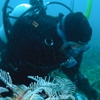General Description
Colony of individual polyps (hydranths) joined by root-like network of tubular stolons at the base. Colony shape is feather-like (pinnate). Colour: buff to dark greyish-brown, sometimes covered by pink coralline alga. Up to 5 cm high.
Biology
These hydroids are widespread in southern Australian seas although some are small and cryptic and therefore not easily seen. Their colonies grow throughout the year, and are fertile in winter.
Habitat
Tidal channels and reef in areas of strong current flow.
Reefs
Distribution guide
Southern Australia.
Species Group
Depth
Water Column
Max Size
5 cm
Diet
Plankton or Particles
Harmful
Generally not harmful but still able to sting bare skin.
Commercial Species
No
Identify
Conservation Status
- DSE Advisory List : Not listed
- EPBC Act 1999 : Not listed
- IUCN Red List : Not listed






